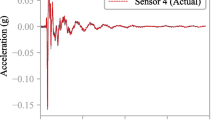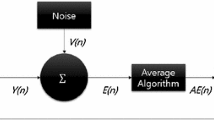Abstract
Floor vibrations for event localization has gained attention recently for its human-related applications such as footstep tracking. However, noise can corrupt signals, reduce signal-to-noise ratios (SNR), and lead to imprecise estimations of the event’s amplitude and force. Techniques to remove noise have been developed such as bandpass filters, which eliminate noise without regard to overlapping event frequency components. These methods can corrupt the signal, removing important information about the event. The authors propose adapting a common speech processing technique, called spectral subtraction using half wave rectification, to remove only the noise’s contribution. The Event Reconstructing Adaptive Spectral Evaluation (ERASE) approach is compared to unfiltered and Butterworth-filtered data in impact localization and force estimation through the Force Estimation and Event Localization (FEEL) Algorithm. A total of 810 impacts from ball drops of five different heights and impulse hammers across eighteen locations were utilized for testing. Signals were corrupted by noise from different sources. ERASE demonstrated 93.9% average impact localization accuracy and -2.40% ± 1.85% force magnitude error on a 99% confidence interval, improving the SNR verse the other filtering techniques.







Similar content being viewed by others
Data Availability
All data, models, or code generated or used during the study are proprietary or confidential in nature.
References
Zhang J, Lutes R G, Liu G, Brambley M R (2013) Energy savings for occupancy-based control (obc) of variable-air-volume (vav) systems. Technical report, Pacific Northwest National Lab.(PNNL), Richland, WA (United States)
Pan S, Yu T, Mirshekari M, Fagert J, Bonde A, Mengshoel O J, Noh H Y, Zhang P (2017) Footprintid: indoor pedestrian identification through ambient structural vibration sensing. Proceedings of the ACM on Interactive, Mobile, Wearable and Ubiquitous Technologies 1(3):1–31
Oguchi K, Iwago M (2018) Human localization in the home by using floor-mounted acceleration sensors. In: 2018 IEEE SENSORS. IEEE, pp 1–4
Ekimov A, Sabatier J M (2006) Vibration and sound signatures of human footsteps in buildings. J Acoust Soc Amer 118(3):2021–768
Li F, Clemente J, Valero M, Tse Z, Li S, Song W (2019) Smart home monitoring system via footstep induced vibrations. IEEE Syst J
Mirshekari M, Pan S, Zhang P, Noh H Y (2016) Characterizing wave propagation to improve indoor step-level person localization using floor vibration. In: Sensors and smart structures technologies for civil, mechanical, and aerospace systems 2016, vol 9803. International Society for Optics and Photonics, p 980305
Bagalà F, Becker C, Cappello A, Chiari L, Aminian K, Hausdorff J M, Zijlstra W, Klenk J (2012) Evaluation of accelerometer-based fall detection algorithms on real-world falls. PloS one 7 (5):e37062
Bourke AK, Van de Ven P, Gamble M, O’Connor R, Murphy K, Bogan E, McQuade E, Finucane P, Olaighin G, Nelson J (2010) Evaluation of waist-mounted tri-axial accelerometer based fall-detection algorithms during scripted and continuous unscripted activities. J Biomech 43(15):3051–3057
Aziz O, Musngi M, Park E J, Mori G, Robinovitch S N (2017) A comparison of accuracy of fall detection algorithms (threshold-based vs. machine learning) using waist-mounted tri-axial accelerometer signals from a comprehensive set of falls and non-fall trials. Med Biol Eng Comput 55(1):45–55
Perry J T, Kellog S, Vaidya S M, Youn J-H, Ali H, Sharif H (2009) Survey and evaluation of real-time fall detection approaches. In: 2009 6th International symposium on high capacity optical networks and enabling technologies (HONET). IEEE, pp 158–164
Ren L, Peng Y (2019) Research of fall detection and fall prevention technologies: a systematic review. IEEE Access 7:77702–77722
Dong Y, Zou J J, Liu J, Fagert J, Mirshekari M, Lowes L, Iammarino M, Zhang P, Noh H Y (2020) Md-vibe: physics-informed analysis of patient-induced structural vibration data for monitoring gait health in individuals with muscular dystrophy. In: Adjunct proceedings of the 2020 ACM international joint conference on pervasive and ubiquitous computing and proceedings of the 2020 ACM international symposium on wearable computers, pp 525–531
Fagert J, Mirshekari M, Pan S, Zhang P, Noh H Y (2020) Structural property guided gait parameter estimation using footstep-induced floor vibrations, vol 2. Springer, pp 191–194
MejiaCruz Y, Franco J, Hainline G, Fritz S, Jiang Z, Caicedo J M, Davis B, Hirth V (2021) Walking speed measurement technology: a review. Current Geriatrics Reports, 1–10
Davis B T, Caicedo J M, Hirth V A (2020) Force estimation and event localization (feel) of impacts using structural vibrations. J Eng Mech. https://doi.org/10.1061/(ASCE)EM.1943-7889.0001890, In Press
MejiaCruz Y, Jiang Z, Caicedo J M, Franco J M (2021) Probabilistic force estimation and event localization (pfeel) algorithm. Eng Struct. https://doi.org/10.1016/j.engstruct.2021.113535
Alajlouni S, Tarazaga P (2019) A new fast and calibration-free method for footstep impact localization in an instrumented floor. J Vib Control 25(10):1629–1638
Davis B T (2016) Characterization of human-induced vibrations. Ph.D. Thesis, University of South Carolina
Giurgiutiu V (2014) Structural health monitoring: with piezoelectric wafer active sensors, 2nd edn. Elsevier
Selesnick I W, Burrus C S (1998) Generalized digital butterworth filter design. IEEE Trans Signal Process 46(6):1688–1694
Abdelgawad A, Mahmud M A, Yelamarthi K (2016) Butterworth filter application for structural health monitoring. Int J Handheld Comput Res (IJHCR) 7(4):15–29
Ravizza G, Ferrari R, Rizzi E, Dertimanis V, Chatzi E N (2019) Denoising corrupted structural vibration response: critical comparison and assessment of related methods. In: 7th International conference on computational methods in structural dynamics and earthquake engineering (COMPDYN 2019), an ECCOMAS thematic conference, an IACM special interest conference. 3. Institute of Structural Analysis and Antiseismic Research, pp 1–12
Antoniadis A, Bigot J, Sapatinas T (2001) Wavelet estimators in nonparametric regression: a comparative simulation study. J Stat Softw 6:pp–1
Jiang X, Mahadevan S, Adeli H (2007) Bayesian wavelet packet denoising for structural system identification. Structural Control and Health Monitoring: The Official Journal of the International Association for Structural Control and Monitoring and of the European Association for the Control of Structures 14 (2):333–356
Nason G P, Silverman B W (1995) The stationary wavelet transform and some statistical applications. Springer, pp 281–299
Coifman R R, Donoho D L (1995) Translation-invariant de-noising. Springer, pp 125–150
Grewal M S, Andrews A P (2014) John Wiley & Sons
Chatzi E N, Fuggini C (2015) Online correction of drift in structural identification using artificial white noise observations and an unscented Kalman filter. Smart Struct Syst 16(2):295–328
Marselli C, Daudet D, Amann H P, Pellandini F (1998) Application of kalman filtering to noisereduction on microsensor signals. In: Proceedings du Colloque interdisciplinaire en instrumentation, C2I, 18-19 novembre 98, pp 443–450. Ecole Normale Supérieure de Cachan, France, pp 443–450
Zhao M, Jia X (2017) A novel strategy for signal denoising using reweighted svd and its applications to weak fault feature enhancement of rotating machinery. Mech Syst Signal Process 94:129–147
Knockaert L, De Backer B, De Zutter D (1999) Svd compression, unitary transforms, and computational complexity. IEEE Trans Signal Process 47(10):2724–2729
Yang W-X, Peter W T (2003) Development of an advanced noise reduction method for vibration analysis based on singular value decomposition. Ndt & E International 36(6):419–432
Gustafsson H, Nordholm S, Claesson I (1999) Spectral subtraction with adaptive averaging of the gain function. In: Sixth European conference on speech communication and technology, pp 10–25
Li S, Wang J-Q, Niu M, Jing X-J, Liu T, et al. (2010) Iterative spectral subtraction method for millimeter-wave conducted speech enhancement. J Biomed Sci Eng 3(02):187
Lu Y, Loizou P C (2008) A geometric approach to spectral subtraction. Speech Commun 50 (6):453–466
Upadhyay N, Karmakar A (2015) Speech enhancement using spectral subtraction-type algorithms: a comparison and simulation study. Procedia Comput Sci 54:574–584
Yamashita K, Ogata S, Shimamura T (2007) Improved spectral subtraction utilizing iterative processing. Electron Commun Japan (Part III: Fund Electron Sci) 90(4):39–51
Lim J S, Oppenheim A V (1979) Enhancement and bandwidth compression of noisy speech. Proc IEEE 67(12):1586–1604
Abd El-Fattah MA, Dessouky M I, Diab S M, Abd El-Samie F E-S (2008) Speech enhancement using an adaptive wiener filtering approach. Progress Electromagn Res 4:167–184
Berouti M, Schwartz R, Makhoul J (1979) Enhancement of speech corrupted by acoustic noise. In: ICASSP’79. IEEE International conference on acoustics, speech, and signal processing, vol 4. IEEE, pp 208–211
Kamath S, Loizou P, et al. (2002) A multi-band spectral subtraction method for enhancing speech corrupted by colored noise.. In: ICASSP, vol 4. Citeseer, pp 44164–44164
Lim J S (1990) Two-dimensional signal and image processing. Englewood Cliffs
Chen J, Benesty J, Huang Y, Doclo S (2006) New insights into the noise reduction wiener filter. IEEE Trans Audio Speech Lang Process 14(4):1218–1234
Zhang Y, Pan S, Fagert J, Mirshekari M, Noh H Y, Zhang P, Zhang L (2018) Occupant activity level estimation using floor vibration. In: Proceedings of the 2018 ACM international joint conference and 2018 international symposium on pervasive and ubiquitous computing and wearable computers, pp 1355–1363
Huston S P (2010) Structural health monitoring of a high speed naval vessel using ambient vibrations. Ph.D. Thesis, Georgia Institute of Technology
Gunawan F E (2016) Impact force reconstruction using the regularized wiener filter method. Inverse Probl Sci Eng 24(7):1107–1132
Ogata S, Shimamura T (2001) Reinforced spectral subtraction method to enhance speech signal. In: Proceedings of IEEE region 10 international conference on electrical and electronic technology. TENCON 2001 (Cat. No. 01CH37239), vol 1. IEEE, pp 242–245
Na S, Li W, Liu Y (2016) An improved spectral subtraction algorithm for speech enhancement system. In: 6th International conference on information engineering for mechanics and materials. Atlantis Press
Boll S (1979) Suppression of acoustic noise in speech using spectral subtraction. IEEE Trans Acoust Speech Signal Process 27(2):113–120
Acknowledgments
The authors would like to thank Parker Kelly and Brianna Bryant for assisting in collecting the data used in this work.
Funding
Research reported in this document was supported by the National Institute on Aging (NIA) of the National Institutes of Health (NIH) under Award Number R41AG059475. The content is solely the responsibility of the authors and does not necessarily represent the official views of the National Institute of Health.
Author information
Authors and Affiliations
Corresponding author
Ethics declarations
Conflict of Interests
On behalf of all authors, the corresponding author states that there is no conflict of interest.
Additional information
Publisher’s Note
Springer Nature remains neutral with regard to jurisdictional claims in published maps and institutional affiliations.
Rights and permissions
About this article
Cite this article
MejiaCruz, Y., Davis, B. Event Reconstructing Adaptive Spectral Evaluation (ERASE) Approach to Removing Noise in Structural Acceleration Signals. Exp Tech 47, 827–837 (2023). https://doi.org/10.1007/s40799-022-00598-x
Received:
Accepted:
Published:
Issue Date:
DOI: https://doi.org/10.1007/s40799-022-00598-x




